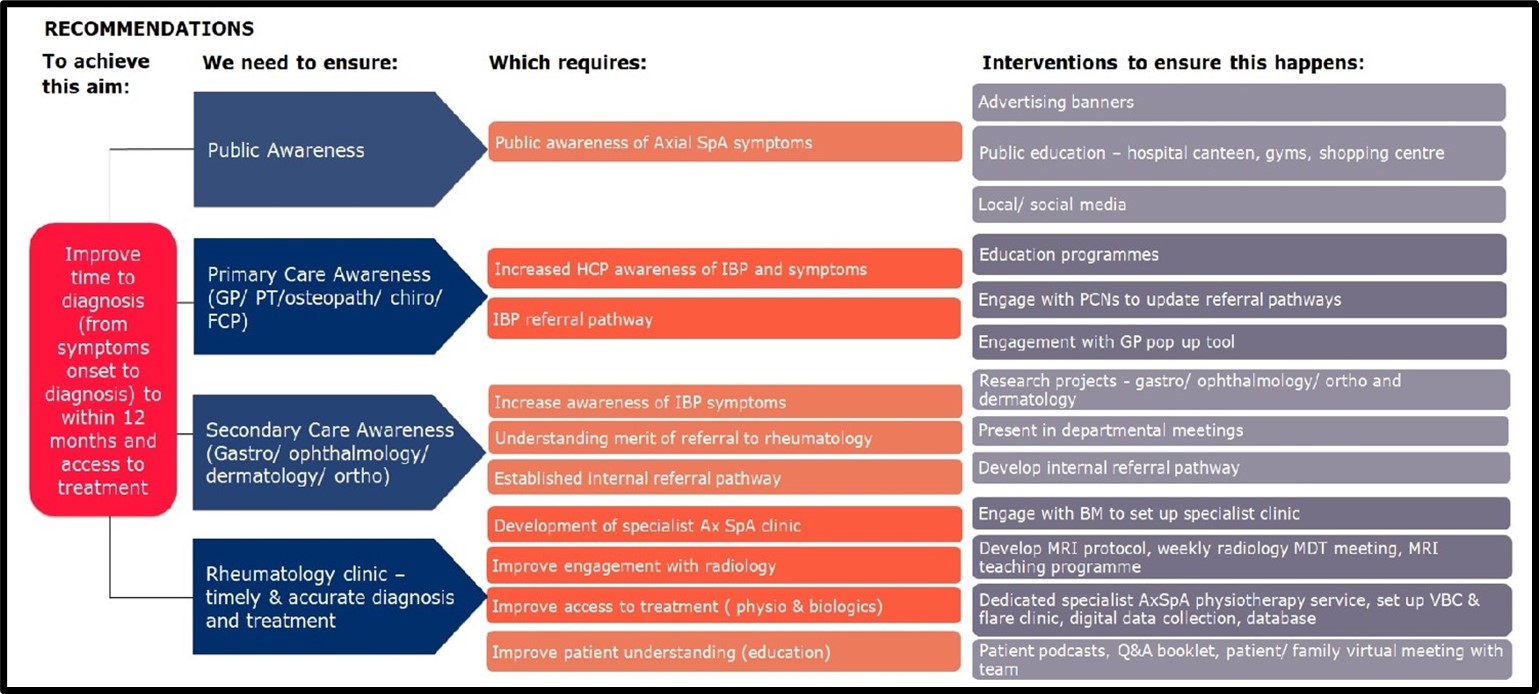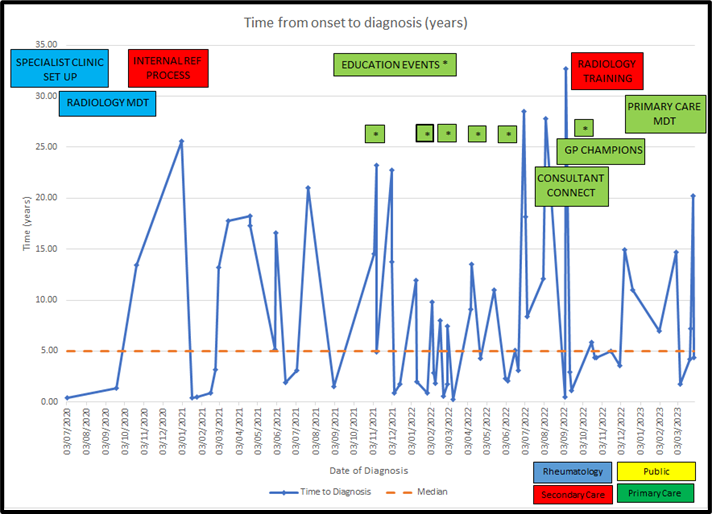Tackling the Delay to Diagnosis using the NASS Gold Standard
Blog by Sian Bamford, Nahid Islam and Professor Hassan Tahir of the Royal Free NHS Foundation Trust.
Background
The team at Barnet Hospital joined the Aspiring to Excellence programme as part of cohort two in May 2021 with an ambition to provide a world class axial spondyloarthritis (axial SpA) service at the Royal Free London NHS Foundation Trust. Our main aim was to reduce the delay to diagnosis to one year in line with the Act on Axial SpA: A Gold Standard Time to Diagnosis, and to improve timely access to treatment for patients once diagnosed with axial SpA.
Where did you start your journey?
Initially, we collected baseline delay to diagnosis data in our cohort of patients via an electronic questionnaire. Our median delay to diagnosis was calculated at 6.09 years and although this is below the national average of 8.5 years, we were not achieving the NASS gold standard of one year. The data identified that a significant proportion of the delay to diagnosis occurred in primary care. Individuals had been seeing a variety of healthcare professionals in primary care, but it had taken some time for them to be referred from primary to secondary care rheumatology services.
The team developed a driver diagram to identify the various drivers influencing the current delay to diagnosis and treatment and we established the various interventions needed to influence change.

What interventions did you introduce?
Over the two-year Aspiring to Excellence programme, we have carried out several initiatives.
- To raise public awareness we have designed pull up banners incorporating the NASS symptoms checker which highlights the symptoms of inflammatory back pain. The banners are displayed in various locations within our hospitals.
- To raise primary care awareness, we have carried out multiple teaching sessions to a variety of healthcare professional including GPs, FCPs, physiotherapists and osteopaths both within our locality and further afield. We have updated our referral process and information regarding our service on primary care systems and our Trust website. We also run a monthly rheumatology radiology MDT meeting for our primary care colleagues to discuss any relevant cases.
- Within secondary care we have carried out research projects and teaching sessions with our colleagues in the ophthalmology, dermatology and gastroenterology services. We have also carried out teaching sessions with the physiotherapy teams which have helped to increase awareness of axial spondyloarthritis. An internal referral pathway for patients with suspected axial spondyloarthritis has been established.
- To improve timely and accurate diagnosis and treatment of patients with suspected axial spondyloarthritis we now run a biweekly specialist clinic with a consultant rheumatologist and advanced practice physiotherapist. We also have a weekly rheumatology radiology MDT meeting to review imaging and a weekly virtual biologic meeting to improve our biologic application process. We run a monthly virtual axial spondyloarthritis patient education session and patients can access specialist individual or group physiotherapy from the session. We have also developed an education booklet, podcasts and exercise resource for our patients.
We have evaluated the impact of these various interventions on delay to diagnosis using run charts.
What barriers did you face taking the project forward?
The main barriers faced whilst working on the project were the large number of people that sometimes need to be involved when trying to implement change and the time this can take.
Reduced manpower in other teams and financial constraints have also been a barrier to the progression of one of our projects.
Were there any light bulb moments? Or big wins?
There have been many small wins on our journey to date and hopefully the big win will be eventually achieving the gold standard one year delay to diagnosis.
What was the result of your project? Is it still a work in progress or do you have outcomes you can share at this time?
At the end of the 2 year Aspiring to Excellence programme we reviewed our delay to diagnosis data which is now collected nationally via the NASS time to diagnosis audit and our delay had reduced from 6.09 years to 5 years. From the run chart below, you can see that no one intervention has had a significant effect on delay to diagnosis.

The team were pleased with the results, but we are continuing with our improvement work to try and achieve the NASS gold standard.
We will continue to contribute to the NASS time to diagnosis audit to monitor the effectiveness of our service improvement work.
Aspiring to Excellence in Axial SpA
Our quality improvement improvement programme Aspiring to Excellence has a range of tools, including podcasts, videos on QI basics and posters produced by the teams. You can also find our values-based quality standards, and the Time Flies toolkit to help you implement these.